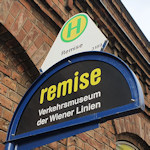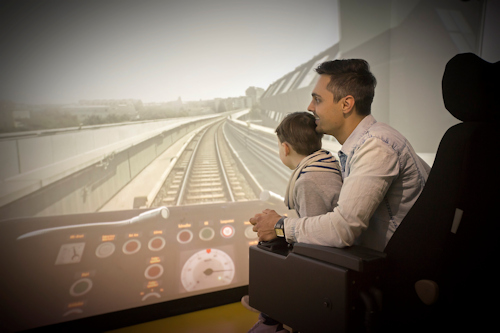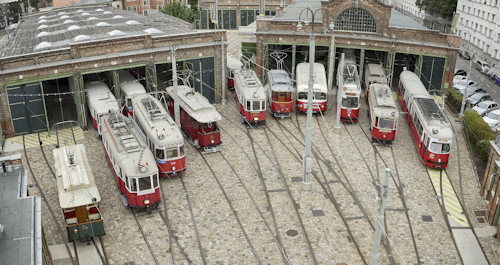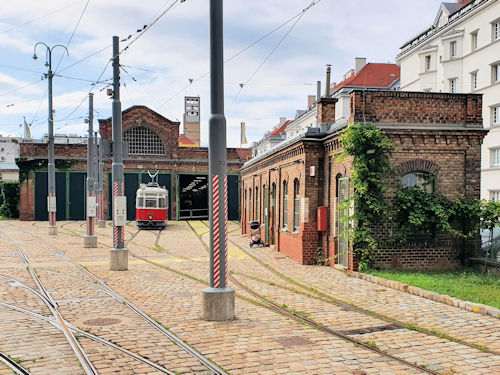
Wander into a tram shed and you, understandably, expect to find a few trams. But perhaps not quite as many as live inside the tram sheds of Vienna’s Transport Museum (Remise).
- Dozens of municipal transport vehicles on display
- Explores the evolution of public transport in Vienna
- See also:
- Included in a Vienna Pass
- Hop-on, hop-off bus tours
- Public transport in Vienna
Trams galore

(Remise is German for tram depot and also an old word for a coach house)
If you like a bit of rattle and roll in your life, then front up to the Remise museum, which has a large tram shed full to the brim with vehicles from over 150 years of public transport.
The museum takes you along the history of municipal transport in Vienna…from an 1868 two-horse open car and 1884 steam tramway all the way through to the future of city travel.
As such, you get to see (from the outside) an awful lot of wonderful old-timer trams, with the occasional other type of vehicle thrown in for good measure.
So, for example, a recent addition to the collection is the actual bus that fell into the Danube river after the collapse of the Reichsbrücke bridge in 1976.
The vehicles form one of two main elements to the museum, which is run by Wiener Linien (the municipal transport authority who operate Vienna’s excellent public transport system).

(The subway simulator; press photo courtesy of and © Wiener Linien; photo by YF Architekten and Franz&Sue)
The second element is a series of interactive information stations that offer insights into some milestone, era or concept relevant to the evolution of public transport in Vienna.
You (or the kids) get to press buttons and enjoy other playful options. This includes two simulators: one for a subway train and another for the 13A bus. That bus follows a notoriously challenging route through narrow and busy streets.
Labels on the vehicles and summary displays at each of the interactive stations include English translations. However, individual exhibits and activities within those stations tend to feature German text only.
This language barrier does limit the visitor experience somewhat at the info stations, though the visual material (and the vehicles, obviously) still have value and an audioguide app in English fills in some of the gaps.

(Some of the trams and other historical vehicles at the museum; press photo courtesy of and © Wiener Linien and Johannes Zinner)
Several of the information displays still caught my eye. For example:
- Old photos of passengers waiting at the Hütteldorf station in 1900. The elegance of the clothes could not contrast more with today’s egalitarianism
- Sightseeing tours of Vienna by tram from as far back as 1907
- The transport struggles of post-WWI. For example, the Stadtbahn city railway stopped running for lack of coal
- Photos from the period of fascism in the 1930s and early 1940s:
- The devastation of aerial WWII bombing
- The tragic executions of transport workers who resisted Nazi rule (or who were simply accused of resisting)
- The celebrating masses on vehicles decorated with swastikas
Incidentally, Hitler made the Austrians drive on the right. Only when you learn this do you realise all photos from pre-Nazi Vienna have vehicles driving on the left.
- Photos of the desolate state of some stations in the 1960s (compare with their near-pristine condition today)

(View from outside)
All-in-all, I’d say the Remise museum makes sense for those with a specific interest in transport and history (and is a real treat for lovers of old-timer trams), but won’t be high up the priority list for the casual tourist.
Tickets and visitor tips
At the time of writing, an adult ticket to the Transport Museum cost €8; kids under 15 can go in free if accompanied by an adult. A Vienna Pass sightseeing card (see my review) gets you one-time entry for free.
Some visitor tips:
- Museum opening times are limited so check locally before travel
- The ticket office has a small shop attached with themed clothing and souvenirs, including models. The shop opens daily.
- A small building on the right after you go through into the museum area has a drinks machine and coin-operated lockers
- Rather helpfully, yellow arrows on the ground guide you to and through the buildings
- The museum lies close to the Donaukanal river channel, and the riverside paths back into Vienna’s centre are quite picturesque from this point
How to get to the Remise
You won’t bump into the museum on any of the traditional tourist routes, but public transport gets you there easily (it would be a little ironic if it didn’t).
Subway: take the U3 line to Schlachthausgasse station and walk up (the U3 leaves from the very centre of town, for example from Stephansplatz station).
Tram/bus: tram 18 also stops at Schlachthausgasse or there are two bus lines (77A and 80A) that stop at Ludwig-Koeßler-Platz.
Address: Ludwig-Koeßler-Platz, 1030 Vienna | Website